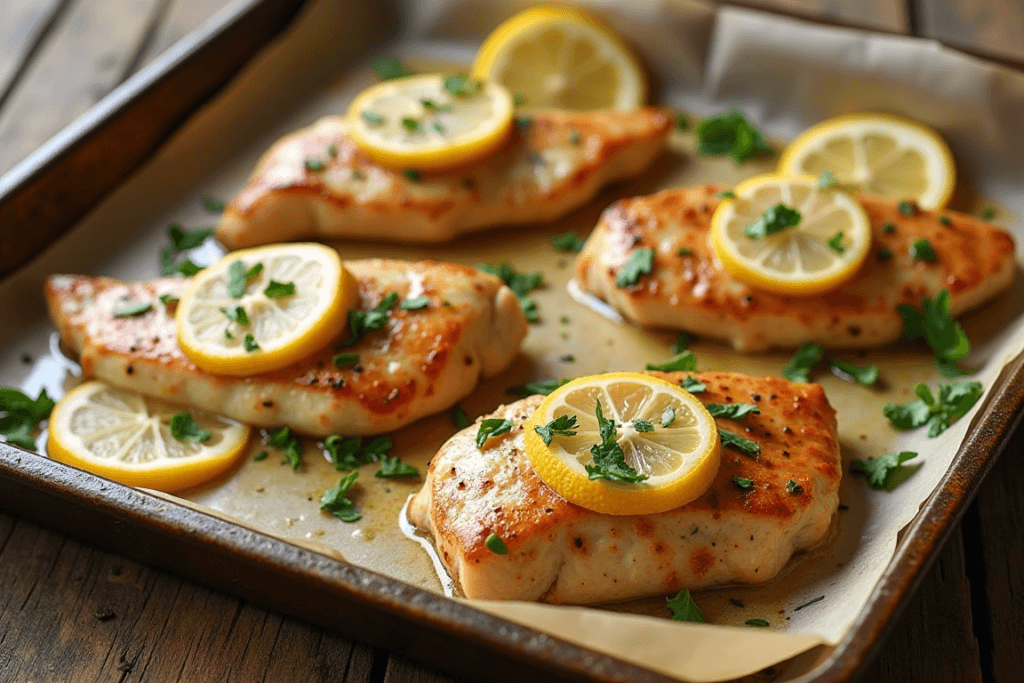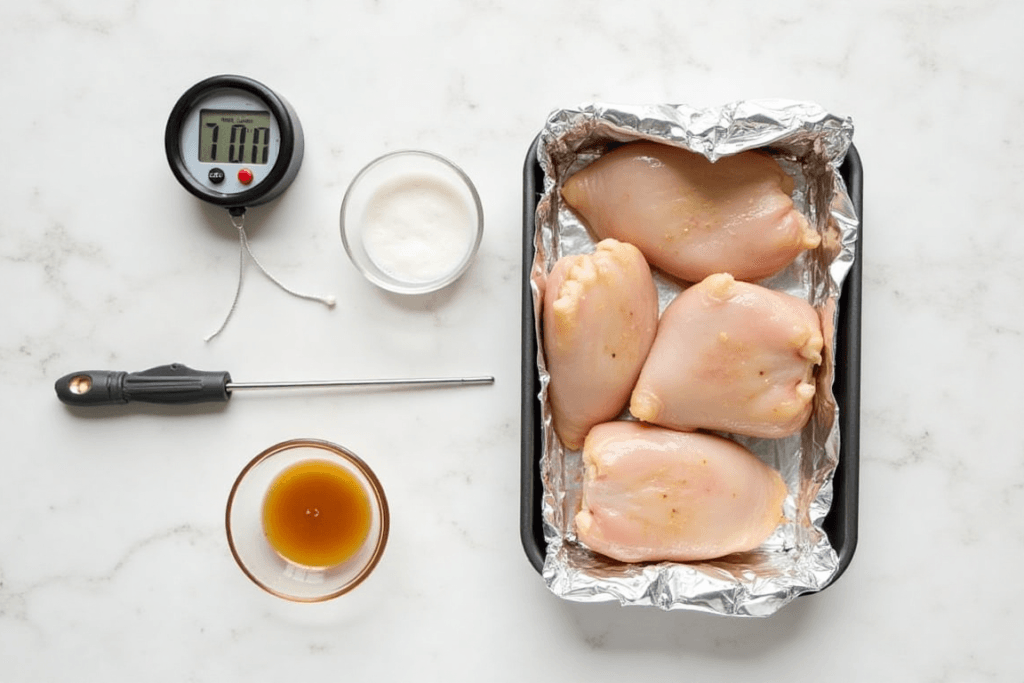Let’s be honest—baking chicken can sometimes feel like a guessing game. Have you ever pulled a chicken breast out of the oven only to find it dry, rubbery, or downright disappointing? Thin chicken breasts, in particular, can be tricky to get just right because they cook so quickly. That’s where this guide comes in!
We’re diving into everything you need to know about baking thin chicken breasts at 350°F. Whether you’re a kitchen pro or a total newbie, this step-by-step guide will help you create juicy, flavorful chicken every single time. Sound good?
Table of Contents
Why Thin Chicken Breasts Are a Popular Choice
So, why are thin chicken breasts such a big deal? Here are a few reasons:
- Quick Cooking: They’re ideal for weeknight dinners when you don’t have hours to spare.
- Even Cooking: Because they’re uniform in size, you don’t have to worry about one part being undercooked.
- Versatility: You can use them in sandwiches, salads, pasta dishes, or just enjoy them on their own.
It’s no wonder these little cuts of poultry are a household favorite!
If you’re looking for creative ways to use chicken in your meals, check out thin sliced chicken breast recipes: 15 quick and healthy meal ideas for inspiration!

Ideal Baking Time for Thin Chicken Breasts at 350°F
General Baking Time Guidelines
The magic number for baking thin chicken breasts at 350°F is around 25-30 minutes. This range ensures the chicken is fully cooked while staying juicy and tender. However, there are a few factors to keep in mind, which we’ll cover next.
Factors That Can Affect Baking Time
Not all chicken breasts are created equal, and several things can impact cooking time:
- Thickness: Even though they’re thin, a slightly thicker cut may take closer to 30 minutes.
- Oven Variations: Every oven is different, and some may run hotter or cooler than others.
- Bone-In or Boneless: Thin bone-in breasts take longer to bake compared to boneless ones.
When in doubt, a meat thermometer is your best friend. The internal temperature should reach 165°F for safely cooked chicken.
Pro Tip: Invest in a reliable digital meat thermometer. It removes all the guesswork from cooking chicken!
Common Mistakes to Avoid When Baking Thin Chicken Breasts
Overbaking or Undercooking Issues
Overbaking dries out the chicken faster than you can say “dinner’s ready.” On the flip side, undercooking can leave you with rubbery chicken—and nobody wants that. Always keep an eye on the clock and check the internal temperature if you’re unsure.
Not Using a Meat Thermometer
We can’t stress this enough: guessing if the chicken is done is a gamble. A thermometer removes all doubt, ensuring perfect results every time. Plus, it helps prevent that awkward moment of cutting into a raw piece at the table.
Skipping the Preheating Step
Think of your oven as a marathon runner—it needs a warm-up! Preheating ensures your chicken bakes evenly and consistently. Always give your oven at least 10-15 minutes to preheat before putting the chicken in.
Step-by-Step Guide to Baking Thin Chicken Breasts at 350°F
Preparing the Chicken Breasts
Start by prepping your chicken. If your breasts are slightly thicker than desired, you can pound them to an even thickness using a meat mallet or rolling pin. This guarantees even cooking and minimizes the chance of overcooking one side.
Seasoning and Marinating Tips
Here’s where you can get creative! Seasoning is your secret weapon for flavorful chicken. A simple mix of salt, pepper, garlic powder, and paprika works wonders. Want to elevate things? For the best flavor, marinate the chicken for at least 30 minutes.Here’s a quick marinade recipe to try:
Simple Chicken Marinade
- Olive Oil: 2 tablespoons
- Lemon Juice: 1 tablespoon
- Garlic: 2 cloves, minced
- Honey: 1 teaspoon
- Salt and Pepper: To taste
Combine ingredients in a bowl, add the chicken, and let it soak up the flavors in the fridge!
Setting the Right Oven Temperature
Preheat your oven to 350°F. While waiting, line a baking dish with parchment paper or lightly grease it to prevent sticking. Place the chicken breasts in a single layer to ensure even cooking.
Monitoring Cooking Time and Doneness
Set your timer for 25 minutes and check the chicken’s internal temperature toward the end of the baking time. If it’s not quite at 165°F, give it a few more minutes. Be careful not to overcook it!
Did You Know? Letting chicken rest for 5 minutes after baking helps retain its juices. Slice it too soon, and you’ll lose all that moisture!

How to Ensure Juicy and Tender Thin Chicken Breasts
The Role of Brining
If you’ve ever wondered how professional chefs make their chicken taste so juicy, the answer might be brining. This simple process involves soaking the chicken in a saltwater solution before cooking. Why? The salt helps the chicken retain moisture, resulting in tender, flavorful meat.
Basic Brine Recipe
- Water: 4 cups
- Salt: 1/4 cup
- Optional Add-Ins: Sugar, garlic, or herbs for extra flavor
Mix until the salt dissolves, submerge the chicken, and refrigerate for 30 minutes to 2 hours. Rinse and pat dry before baking.
Using Foil or Parchment Paper for Moisture Retention
Want to lock in all those delicious juices? Try baking your chicken breasts covered. Wrapping them in foil or using parchment paper creates a steamy environment, keeping the chicken from drying out. Think of it like a mini sauna for your chicken—it stays juicy and tender!
Resting the Chicken After Baking
This step might sound skippable, but trust me, it’s not. Resting your chicken for 5-10 minutes after baking allows the juices to redistribute throughout the meat. If you cut into it right away, those precious juices will spill out, leaving you with dry chicken.
Troubleshooting Common Problems
Why Does My Chicken Turn Out Dry?
Dry chicken is the bane of many home cooks, but it’s often caused by overbaking. Thin chicken breasts cook fast, so even a few extra minutes in the oven can lead to dryness. Always check the internal temperature and pull the chicken out at 165°F.
How to Fix Undercooked Chicken Breasts
Accidentally undercooked your chicken? Don’t panic! Simply pop it back in the oven or sear it in a hot skillet for a few minutes. Just make sure it reaches that safe internal temperature.
Preventing Chicken From Sticking to the Pan
There’s nothing worse than losing half your chicken to the pan. To prevent this, always grease your baking dish or use parchment paper. You can also lightly coat the chicken with olive oil for an extra layer of protection.
Alternative Cooking Methods for Thin Chicken Breasts
Grilling Thin Chicken Breasts
If you’re in the mood for smoky, charred flavors, grilling is a great option. Preheat your grill to medium-high heat, season the chicken, and cook for 4-5 minutes per side. Make sure to keep an eye on it—thin chicken cooks quickly on the grill!
Pro Tip: Use a meat thermometer even when grilling. It ensures you don’t overcook or undercook your chicken.
Searing and Finishing in the Oven
This technique combines the best of both worlds: a crispy exterior and a juicy interior. Start by searing the chicken in a hot skillet with a bit of oil for 1-2 minutes per side. Then, transfer it to a preheated oven at 350°F and bake for about 15 minutes. The result? Perfectly cooked chicken with a golden crust.
Air Fryer Option for Quick Cooking
Air fryers are all the rage, and for good reason—they’re fast, convenient, and great for thin chicken breasts. Preheat your air fryer to 350°F, season the chicken, and cook for 8-10 minutes, flipping halfway through. It’s like magic: crispy on the outside, juicy on the inside!
For a detailed air fryer guide, visit can you air fry thin sliced chicken breast?.
Tips for Meal Prep with Thin Chicken Breasts
Storing Baked Chicken Properly
Planning to bake chicken ahead of time? Make sure to store it correctly to keep it fresh. Allow the chicken to cool fully before storing it in an airtight container. Refrigerate for up to 4 days or freeze for longer storage.
Reheating Without Drying Out
Reheated chicken often ends up dry, but it doesn’t have to! To keep it juicy, reheat the chicken in the oven at 300°F with a splash of broth or water. Cover it with foil to lock in moisture, and heat until warmed through.
Creative Recipes Using Baked Thin Chicken Breasts
Baked chicken is a meal prep superstar because it works in so many recipes. Here are a few ideas to get you started:
- Chicken Caesar Salad: Slice the chicken and toss it with crisp romaine, croutons, and creamy Caesar dressing.
- Chicken Wraps: Combine the chicken with fresh veggies and your favorite sauce in a tortilla.
- Pasta Primavera: Dice the chicken and mix it into a colorful pasta dish with seasonal veggies.
Health Benefits of Baking Chicken Breasts at 350°F
Lower Fat Content Compared to Frying
If you’re trying to eat healthier, baking chicken is a fantastic option. Unlike frying, which adds extra oil and calories, baking requires minimal fat. A light coating of olive oil or cooking spray is all you need to keep your chicken juicy and flavorful without unnecessary grease.
Retaining Nutritional Value Through Proper Cooking
Baking chicken at 350°F is not only easy but also great for preserving its nutritional value. Chicken breasts are a lean source of protein, packed with essential nutrients like niacin, selenium, and B vitamins. Cooking at a moderate temperature ensures these nutrients stay intact, making baked chicken a smart choice for a balanced diet.
Nutrition Facts for Baked Thin Chicken Breast (4 oz serving):
Nutrient Amount Calories 120 Protein 26g Fat 2g Carbohydrates 0g
Frequently Asked Questions About Baking Thin Chicken Breasts
Can I Bake Frozen Thin Chicken Breasts at 350°F?
Yes, but it’s not ideal. Baking frozen chicken takes longer, and the texture might not be as tender. If you’re in a pinch, bake the frozen chicken at 350°F for 45-50 minutes, but consider thawing it first for better results. The safest and most effective way to thaw is in the refrigerator overnight.
How Do I Know When My Chicken Is Fully Cooked?
The easiest way to tell if your chicken is done is by checking the internal temperature. It should reach 165°F in the thickest part. If you don’t have a thermometer, you can cut into the chicken—it should be white with clear juices (no pink).
What Are the Best Seasonings for Baked Chicken?
Seasoning is your chance to let your creativity shine! Here are a few popular seasoning blends to try:
- Italian Blend: Basil, oregano, garlic powder, and a pinch of red pepper flakes.
- Southwest Spice: Chili powder, cumin, paprika, and a dash of lime juice.
- Herb Butter: Fresh rosemary, thyme, and a dollop of softened butter spread on top.
Don’t be afraid to mix and match flavors to create your signature dish!
Conclusion: Perfectly Baked Thin Chicken Breasts Every Time
Summary of Key Tips and Techniques
To recap, baking thin chicken breasts at 350°F is a simple, healthy, and versatile cooking method. Remember these key tips:
- Preheat your oven to ensure even cooking.
- Use a meat thermometer to check for doneness.
- Season generously for maximum flavor.
- Let the chicken rest before slicing to retain moisture.
Encouragement to Experiment with Recipes
Baking chicken doesn’t have to be boring! Use this guide as your starting point, but don’t be afraid to experiment with marinades, seasonings, and side dishes. Whether you’re meal prepping for the week or making dinner for the family, thin chicken breasts are a versatile and reliable choice.
Final Thought: Perfectly baked chicken isn’t just about following a recipe—it’s about finding what works for you. So, roll up your sleeves and get cooking!

